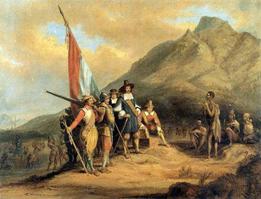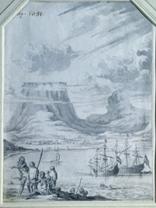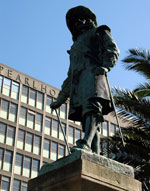-->
Johan Anthoniszoon "Jan" van Riebeeck (21 April 1619 – 18 January 1677) was a Dutch colonial administrator and founder of Cape Town.
Van Riebeeck was born in Culemborg, a culturally Dutch free state then officially part of the Holy Roman Empire, as the son of a surgeon. He grew up in Schiedam, where he married 19-year-old Maria de la Quellerie on 28 March 1649. She died in Malacca, now part of Malaysia, on 2 November 1664, at the age of 35. The couple had eight or nine children, most of whom did not survive infancy. Their son Abraham van Riebeeck, born at the Cape, later became Governor-General of the Dutch East Indies.
Joining the Vereenigde Oost-Indische Compagnie (VOC) (Dutch East India Company) in 1639, he served in a number of posts, including that of an assistant surgeon in the Batavia in the East Indies.
He was head of the VOC trading post in Tonkin, Indochina.
In 1643, Riebeeck travelled with Jan van Elseracq to the VOC outpost atDejima in Japan. Seven years later in 1650, he proposed selling hides of South African wild animals to Japan.[4]
In 1651 he volunteered to undertake the command of the initial Dutch settlement in the future South Africa. He landed three ships (Dromedaris;Reijger and Goede Hoop) at the future Cape Town on 6 April 1652 and fortified the site as a way-station for the VOC trade route between the Netherlands and the East Indies. The primary purpose of this way-station was to provide fresh provisions for the VOC fleets sailing between the Dutch Republic and Batavia, as deaths en route were very high. The Walvisch and the Oliphant arrived later in 1652, having had 130 burials at sea.
Van Riebeeck was Commander of the Cape from 1652 to 1662; he was charged with building a fort, with improving the natural anchorage at Table Bay, planting cereals, fruit and vegetables and obtaining livestock from the indigenous Khoi people. In the Kirstenbosch National Botanical Garden in Cape Town there are a few Wild Almond trees still surviving. The initial fort, named Fort de Goede Hoop ('Fort of Good Hope') was made of mud, clay and timber, and had four corners or bastions. This fort was replaced by the Castle of Good Hope, built between 1666 and 1679 after van Riebeeck had left the Cape.
Van Riebeeck was joined at the Cape by a fellow Culemborger Roelof de Man(1634-1663) who arrived in January 1654 on board the ship Naerden. Roelof came as the colony bookkeeper and was later promoted to second-in-charge.[5]
Van Riebeeck reported the first comet discovered from South Africa, C/1652 Y1, which was spotted on 17 December 1652.
In his time at the Cape, Van Riebeeck oversaw a sustained, systematic effort to establish an impressive range of useful plants in the novel conditions on the Cape Peninsula – in the process changing the natural environment forever. Some of these, including grapes, cereals, ground nuts, potatoes, apples and citrus, had an important and lasting influence on the societies and economies of the region. The daily diary entries kept throughout his time at the Cape (VOC policy) provided the basis for future exploration of the natural environment and its natural resources. Careful reading of his diaries indicate that some of his knowledge was learned from the indigenous peoples inhabiting the region.
References:
- See more at: http://www.sahistory.org.za/topic/arrival-jan-van-riebeeck-cape-6-april-1652#sthash.tTwW5nvU.dpuf
THE STAR - 100 people who made SA (No.1) Dec6 1999
Portrait of Jan van Riebeeck (after original by Dirk Craeij in the Rijksmuseum, Amsterdam), 1972 Source: africamediaonline.com
On 24 December 1651, accompanied by his wife and son, Jan van Riebeeck set off from Texel in The Netherlands for the Cape of Good Hope. Van Riebeeck had signed a contract with the Dutch East India Company (VOC) to oversee the setting up of a refreshment station to supply Dutch ships on their way to the East. Sailing on the Dromedaris with two other ships, the Rejiger and De Goede Hoop, Van Riebeeck was accompanied by 82 men and 8 women.
When Van Riebeeck left The Netherlands in 1651, the Council of Policy, a bureaucratic governing structure for the refreshment station, had already been established. On board the Dromedaris Van Riebeeck conducted meetings with his officials – minutes of the meetings of the Council of Policy, dated from December 1651, have been carefully archived.
Land was sighted on 5 April 1652 and the ships docked the next day. Within a week of the arrival of the three ships, work had begun on the Fort of Good Hope. The aim was to establish a refreshment station to supply the crew of the Company's passing trading ships with fresh water, vegetables and fruit, meat and medical assistance. However, the first winter experienced by Van Riebeeck and his crew was extremely harsh, as they lived in wooden huts and their gardens were washed away by the heavy rains. As a result their food dwindled and at the end of the winter approximately 19 men had died.
The arrival of Van Riebeeck marked the beginning of permanent European settlement in the region. Along with the Council of Policy, Van Riebeeck came equipped with a document called the ‘Remonstrantie’, drawn up in the Netherlands in 1649, which was a recommendation on the suitability of the Cape for this VOC project.
Van Riebeeck was under strict instructions not to colonise the region but to build a fort and to erect a flagpole for signaling to ships and boats to escort them into the bay. However, a few months after their arrival in the Cape, the Dutch Republic and England became engaged in a naval war (10 July 1652 to 5 April 1654). This meant that the completion of the fort became urgent. Fort de Goede Hoop – a fort with four corners made of mud, clay and timber – was built in the middle of what is today Adderley Street. Around this a garden was planted and meat was bartered for with the Khoikhoi (who were initially called Goringhaikwa, and later Kaapmans). The construction for Castle of Good Hope which stands today only began in 1666, after Van Riebeeck had left the Cape, and was completed 13 years later.
Although the VOC did not originally intend to establish a colony at the Cape, permits were issued in February 1657 to free nine company servants (who became the Free Burghers) to farm along the Liesbeeck River in order to deal with a wheat shortage. They were given as much land as they could cultivate in three years but were forbidden to trade with anyone other than the VOC. With the number of private farms increasing, by 1659 the station was producing enough to supply any passing ship. The station also began to experience a chronic labour shortage and because the Khoisan were seen as ‘uncooperative’, slaves were imported from Batavia (now northern Jakarta) and Madagascar in 1657.
The land on which the Dutch farmed was used by the Khoikhoi and the San, who lived a semi-nomadic culture which included hunting and gathering. Since they did not have a written culture, they had neither written title deeds for their land, nor did they have the bureaucratic framework within which to negotiate the sale or renting of land with strangers from a culture using written records supported by a bureaucratic system of governance. Hence Van Riebeeck, coming as he did from a bureaucratic culture with a unilateral, albeit written, mandate to establish a refreshment station, refused to acknowledge that land ownership could be organised in ways different from the Dutch/European way. He denied the Khoisan rights and title to the land, claiming that there was no written evidence of the true ownership of the land. Consequently in 1659 the Khoikhoi embarked on the first of a series of unsuccessful armed uprisings against the Dutch invasion and appropriation of their land – their resistance would continue for at least 150 years.
In response to the growing skirmishes with the local population, in 1660 Van Riebeeck planted a wild almond hedge to protect his settlement. By the end of the same year, under pressure from the Free Burghers, Van Riebeeck sent the first of many search parties to explore the hinterland. Van Riebeeck remained leader of the Cape until 1662. By the time he left the settlement in May 1662 it had grown to 134 officials, 35 Free Burghers, 15 women, 22 children and 180 slaves.
The day of Jan Van Riebeeck’s arrival became a public holiday with the 300th anniversary in 1952 and was celebrated as Van Riebeeck’s Day until 1974. During the tercentenary celebration on 6 April 1952, the Joint Planning Council (made up of members from the ANC, SAIC, SACP and COD) held mass meetings and demonstrations throughout the country as part of the lead up to the Defiance Campaign. The ANC and TIC issued a flyer entitled ‘April 6: People Protest Day’.
In 1980 the public holiday was changed to Founder’s Day. The holiday was abolished in 1994 by the democratically elected ANC government. However, statues of Jan van Riebeeck and his wife remain in Adderley Street, Cape Town. The coat of arms of the city of Cape Town is also based on that of the Van Riebeeck family, and Hoërskool Jan van Riebeeck is a popular Afrikaans high school in the centre of Cape Town. Read more on the history of Cape Town.
When Van Riebeeck left The Netherlands in 1651, the Council of Policy, a bureaucratic governing structure for the refreshment station, had already been established. On board the Dromedaris Van Riebeeck conducted meetings with his officials – minutes of the meetings of the Council of Policy, dated from December 1651, have been carefully archived.
Land was sighted on 5 April 1652 and the ships docked the next day. Within a week of the arrival of the three ships, work had begun on the Fort of Good Hope. The aim was to establish a refreshment station to supply the crew of the Company's passing trading ships with fresh water, vegetables and fruit, meat and medical assistance. However, the first winter experienced by Van Riebeeck and his crew was extremely harsh, as they lived in wooden huts and their gardens were washed away by the heavy rains. As a result their food dwindled and at the end of the winter approximately 19 men had died.
The arrival of Van Riebeeck marked the beginning of permanent European settlement in the region. Along with the Council of Policy, Van Riebeeck came equipped with a document called the ‘Remonstrantie’, drawn up in the Netherlands in 1649, which was a recommendation on the suitability of the Cape for this VOC project.
Van Riebeeck was under strict instructions not to colonise the region but to build a fort and to erect a flagpole for signaling to ships and boats to escort them into the bay. However, a few months after their arrival in the Cape, the Dutch Republic and England became engaged in a naval war (10 July 1652 to 5 April 1654). This meant that the completion of the fort became urgent. Fort de Goede Hoop – a fort with four corners made of mud, clay and timber – was built in the middle of what is today Adderley Street. Around this a garden was planted and meat was bartered for with the Khoikhoi (who were initially called Goringhaikwa, and later Kaapmans). The construction for Castle of Good Hope which stands today only began in 1666, after Van Riebeeck had left the Cape, and was completed 13 years later.
Although the VOC did not originally intend to establish a colony at the Cape, permits were issued in February 1657 to free nine company servants (who became the Free Burghers) to farm along the Liesbeeck River in order to deal with a wheat shortage. They were given as much land as they could cultivate in three years but were forbidden to trade with anyone other than the VOC. With the number of private farms increasing, by 1659 the station was producing enough to supply any passing ship. The station also began to experience a chronic labour shortage and because the Khoisan were seen as ‘uncooperative’, slaves were imported from Batavia (now northern Jakarta) and Madagascar in 1657.
The land on which the Dutch farmed was used by the Khoikhoi and the San, who lived a semi-nomadic culture which included hunting and gathering. Since they did not have a written culture, they had neither written title deeds for their land, nor did they have the bureaucratic framework within which to negotiate the sale or renting of land with strangers from a culture using written records supported by a bureaucratic system of governance. Hence Van Riebeeck, coming as he did from a bureaucratic culture with a unilateral, albeit written, mandate to establish a refreshment station, refused to acknowledge that land ownership could be organised in ways different from the Dutch/European way. He denied the Khoisan rights and title to the land, claiming that there was no written evidence of the true ownership of the land. Consequently in 1659 the Khoikhoi embarked on the first of a series of unsuccessful armed uprisings against the Dutch invasion and appropriation of their land – their resistance would continue for at least 150 years.
In response to the growing skirmishes with the local population, in 1660 Van Riebeeck planted a wild almond hedge to protect his settlement. By the end of the same year, under pressure from the Free Burghers, Van Riebeeck sent the first of many search parties to explore the hinterland. Van Riebeeck remained leader of the Cape until 1662. By the time he left the settlement in May 1662 it had grown to 134 officials, 35 Free Burghers, 15 women, 22 children and 180 slaves.
The day of Jan Van Riebeeck’s arrival became a public holiday with the 300th anniversary in 1952 and was celebrated as Van Riebeeck’s Day until 1974. During the tercentenary celebration on 6 April 1952, the Joint Planning Council (made up of members from the ANC, SAIC, SACP and COD) held mass meetings and demonstrations throughout the country as part of the lead up to the Defiance Campaign. The ANC and TIC issued a flyer entitled ‘April 6: People Protest Day’.
In 1980 the public holiday was changed to Founder’s Day. The holiday was abolished in 1994 by the democratically elected ANC government. However, statues of Jan van Riebeeck and his wife remain in Adderley Street, Cape Town. The coat of arms of the city of Cape Town is also based on that of the Van Riebeeck family, and Hoërskool Jan van Riebeeck is a popular Afrikaans high school in the centre of Cape Town. Read more on the history of Cape Town.
References:
• Aartsma, H (2008). ‘Early history of the Cape Colony, South Africa’ from South Africa Tours and Travel [online]. Available from www.south-africa-tours-and-travel.com [Accessed 6 March 2012]
• SouthAfrica.to (date). ‘Jan van Riebeeck (21 April 1619 - 18 January 1677)’ from SouthAfrica.to [online]. Available from www.southafrica.to
• Turton, A. R. (2009). “A South African Diary: Contested Identity, My Family ”“ Our Story, Part A: Pre-1700” from How many bones must you bury before you can call yourself an Africa? [online]. Available from www.anthonyturton.com [Accessed 7 March 2012]
• SouthAfrica.to (date). ‘Jan van Riebeeck (21 April 1619 - 18 January 1677)’ from SouthAfrica.to [online]. Available from www.southafrica.to
• Turton, A. R. (2009). “A South African Diary: Contested Identity, My Family ”“ Our Story, Part A: Pre-1700” from How many bones must you bury before you can call yourself an Africa? [online]. Available from www.anthonyturton.com [Accessed 7 March 2012]


 Charles Bell (1813-1882) painting of Jan van Riebeeck arrives in Table Bay in April 1652
Charles Bell (1813-1882) painting of Jan van Riebeeck arrives in Table Bay in April 1652 Van Riebeeck’s Original Fort on the Shores of Table Bay, 1658 by Wouter Schouten (1638-1704) . Source: William Fehr Collection. Permission:
Van Riebeeck’s Original Fort on the Shores of Table Bay, 1658 by Wouter Schouten (1638-1704) . Source: William Fehr Collection. Permission: Statue of Jan van Riebeeck, Adderly Street, Cape Town
Statue of Jan van Riebeeck, Adderly Street, Cape Town
No comments:
Post a Comment